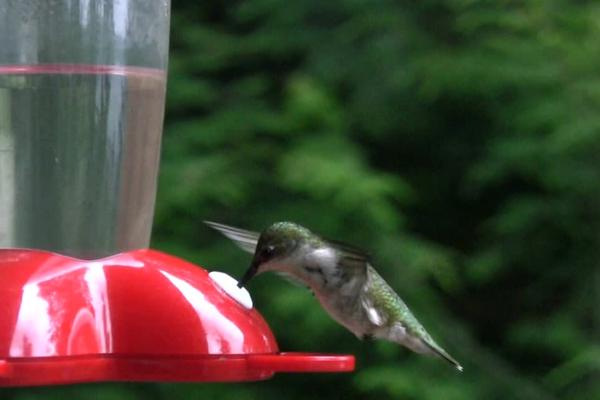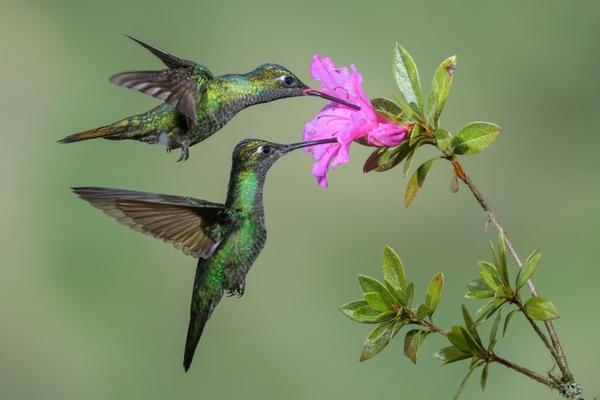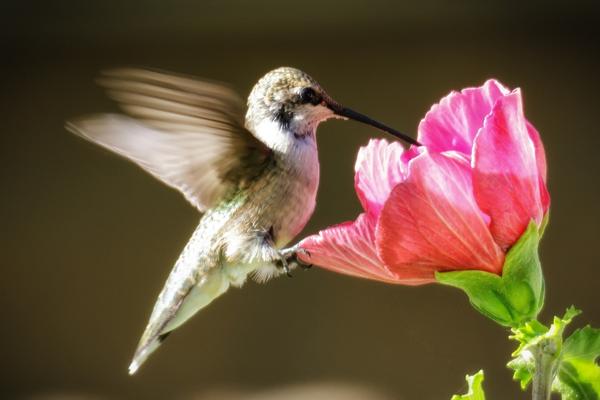All about Birds
A Hummingbird’s Diet: What do Hummingbirds Eat?
Hummingbirds are tiny, beautiful creatures that fill gardens and feeders with their vibrant colors. But what do they eat? To the untrained eye, it might seem like hummingbirds just flitter around looking for flowers and pretty plants to feed on. While they do enjoy nectar from plants, there is much more to a hummingbird’s diet than just nectar.
Hummingbirds are what we call “nectarivores,” meaning their primary source of sustenance is the sugary liquid from flower blossoms. They lap up the nectar with their long tongues, which form a tube shape when extended out of their bill. Hummingbird tongues work similarly to tiny straws, allowing them to suck up nectar quickly and efficiently.
But it’s not just flower nectar that hummingbirds need in their diets; they also eat insects and spiders. This is especially true for baby hummingbirds, who need the protein found in these creatures for rapid growth. Insects are also necessary for adult hummingbirds; they provide important vitamins and minerals to supplement the energy-rich nectar.
While hummingbirds need both nectar and insects, they are not able to eat every kind of insect. In fact, most of the insects that hummingbirds feed on are tiny, like fruit flies and gnats. These bugs provide a good amount of protein without taking up too much energy for the birds to catch. Hummingbirds also sometimes consume spiders and beetles if they can find them.
Hummingbirds also have a unique feeding behavior, called “training.” This refers to the way that hummingbirds travel along a particular route and visit the same flowers in order to feed. By doing this, they can find more food with less effort and save energy for important activities like migration or mating.
Useful: Everything You Need To Know About Hummingbird Feet
Hummingbirds need an abundance of food to fuel their high metabolism and energy needs, so it’s important that they always have access to a variety of foods. To ensure this, many people set up hummingbird feeders in their yards or gardens. Feeders are usually filled with a mixture of sugar and water, which mimics the nectar found in flowers. These feeders can provide an essential food source for hummingbirds, especially during the winter when natural sources may be scarce.
5 Hummingbird food favorites
1. Nectar
Nectar is the most important component of a hummingbird’s diet, and it serves as the fuel for their high-energy lifestyle. Hummingbirds love sweet nectar from flowers, tubular feeders, and even homemade recipes. For hummingbirds living in urban areas, flower gardens are an ideal source of nectar. If you have a garden in your yard, planting its bitsy flowers like begonias, lantana, and fuchsia can help attract hummingbirds.
2. Ripe Fruit

Fruit is a great source of nutrition for hummingbirds, and they’ll often feed on it year-round. You can offer them slices of banana, oranges, apples, and other fruits that are ripe. Because rotting fruit can attract pests like flies and ants, make sure to keep the area clean so that only birds feed on it.
3. Tree Sap

Hummingbirds also love tree sap, and they’ll often take advantage of sources like sapsucker wells or sugar water feeders. This is especially beneficial in the springtime when natural nectar sources may be scarce.
4. Sugar water

Sugar water or bird-friendly nectar is another great way to attract hummingbirds. Making your own sugar water mix is easy and inexpensive. Just combine four parts of room-temperature water with one part of white sugar, and you’ve got an instant hummingbird feast!
5. Flower buds

Another favorite of hummingbirds is flower buds, like those found on hibiscus, poppies, and clovers. These flowers are rich in proteins and other nutrients that can help keep a hummingbird’s energy levels up throughout the day.
Related Articles: The Perfect Hummingbird Food Recipe
Why do hummingbirds love nectar?

Hummingbirds have a very fast metabolism, which is why they feed so frequently. To meet their energy needs, hummingbirds rely on the concentrated sugars found in nectar for quick and easy nutrition. The high-energy content of nectar is perfect for these birds that spend most of their time zooming around, hovering midair, and flitting about. Nectar also provides essential minerals and vitamins, making it a great source of nutrition for hummingbirds.
But nectar isn’t the only thing hummingbirds eat! These birds are incredibly adaptable and opportunistic feeders, which means they will take advantage of any food sources available to them in their environment. From spiders and beetles to sap and flower petals, hummingbirds feed on a wide variety of insects, fruits, and other plant material.
Insects make up the bulk of a hummingbird’s diet. High in protein and low in carbohydrates, these tiny bugs provide essential nutrients for each species of bird. Hummingbirds may use their long, thin beaks to catch insects midair or pluck them from spider webs. They may also seek out the larvae and eggs of moths, butterflies, and flies.
Related articles: How To Choose The Best Hummingbird Feeder
Hummingbirds need water!

Hummingbirds get most of the water they need from the nectar they consume, but they also drink from puddles and dewdrops. Hummingbirds are especially attracted to moving water sources like fountains and birdbaths. If you put out a shallow dish of fresh water in your yard, you may attract these birds!
Hummingbirds also need electrolytes, so a birdbath with a dripper or mister is ideal. The moving water helps attract the birds and it also replenishes their electrolytes. If you can’t provide a birdbath, try tying up old CDs around your yard which will catch the sun’s rays and create moving water patterns.
In addition to nectar and water, hummingbirds also eat insects. These tiny birds need lots of protein and fat to maintain their metabolism and they can’t get it all from nectar alone. A great way to supplement the hummingbird’s diet is by providing an insect feeder or putting out a shallow dish of water with a few drops of sugar in it. The sugar will attract insects which the hummingbirds can then snap up.
Hummingbirds also need minerals and other vitamins, so providing a birdbath with some grit or finely ground oyster shell will help provide that nutrition. You can also add some mineral-rich foods like cut-up apples, oranges, or even banana slices to the water. It’s important to make sure that the food is not too sugary since this can make them sick.
What you can do in your garden?

If you want to attract hummingbirds to your garden, there are a few things that you can do. Planting flowers is one of the best ways to bring them in. Flowers provide nectar for these tiny birds and it is their main source of food. Locate flower gardens near your house or in any other spots where hummingbirds are likely to be seen. Plant a variety of plants, including annuals and perennials, that flower throughout the spring and summer months. Some popular flowers for hummingbirds are bee balm, columbine, cardinal flower, petunias, phlox and salvias.
You can also provide hummingbirds with food by setting up a hummingbird feeder in your garden. Fill the hummingbird feeder with a nectar solution made of one part white sugar and four parts water. You can also buy commercial nectars that are specifically made for hummingbirds available in the market. Place the feeder near a tree, bush or other structure so that the hummingbirds feel safe while they feed.
Planting trees and shrubs that produce berries is also a great way to attract these amazing creatures to your garden. Berries such as elderberry, blueberry, and holly are a favorite food of hummingbirds. They love to sip on the nectar from the flowers while they feast on the juicy fruits. In addition, you can also place a shallow bird bath or trough filled with water and rocks in your garden. This will provide them with an even easier way to get the water they need for drinking and bathing.
Final thoughts
Hummingbirds are a delight to watch with their vibrant colors and impressive aerobatics. Their diet consists of nectar, insects, tree sap, and other small foods they can find in the wild. It is important to provide hummingbirds with food sources both in your garden and away from it so that they have access to a variety of food sources.
FAQS
Why don’t hummingbirds drink from my feeder?
There are several possible reasons why your hummingbird feeder may not be attracting these lovely birds. The most common issue is that it’s not filled with the right kind of food or kept clean enough for them to drink from.
Hummingbirds prefer fresh sugar water, so if your feeder has been sitting out in direct sunlight for too long, the food inside may have gone bad. Additionally, if your feeder isn’t kept clean and free of mold or dirt, hummingbirds will be less likely to visit it. To ensure that you attract hummingbirds to your feeder, make sure to keep it filled with fresh sugar water, and give it a thorough cleaning every few weeks.
How often should you change hummingbird sugar water?
Hummingbird sugar water should be changed every three to five days, depending on the weather. When temperatures are hotter, the sugar water will spoil faster, so it’s important to change it more frequently in hot climates.
If you’re having a lot of visitors and they’re drinking a lot of nectar, then you may need to change it every day as well. It’s also important to remember that hummingbirds cannot digest spoiled sugar water, so it is essential to keep the nectar fresh, clean and safe for your feathered friends.
When you are ready to change the sugar water in your hummingbird feeder, it is important to thoroughly clean the feeder using hot, soapy water. Rinse it well and make sure that any debris or waste has been removed. Then fill the feeder with fresh sugar water and set it back outside where hummingbirds can reach it.
It’s also important to remember that when you’re making your own sugar water, the mixture should be one part white table sugar to four parts water. Do not use honey, artificial sweeteners, or colored sugar as these can be harmful to the birds. Additionally, although hummingbirds may visit a feeder with red liquid in it, they cannot actually see the color red very well and are more attracted to feeders that move or sway.
Hummingbird migration. Spring and fall migration information?
Hummingbirds are beloved by many for their beautiful colors, dazzling flight, and sweet songs. But did you know that hummingbirds migrate twice a year? Every spring and fall, hummingbirds embark on an incredible journey that takes them thousands of miles between their summer breeding grounds and winter roosts.
In the late summer and early fall, hummingbirds begin their journey south. During this time, they will travel up to 3,000 miles in search of warmer climates and better food sources. Along the way, they must stop frequently to rest and refuel after long flights over land or sea.
Do hummingbirds eat fruit?
Yes, many species of hummingbirds will readily consume a variety of fruits. In the wild, they may feed on berries such as elderberries and blueberries, as well as other small fruits like cherries and currants.
When offered fresh fruit in bird feeders or through backyard gardening, common favorites among hummingbirds include oranges, grapefruits, and apples. Fruits with high sugar content are particularly attractive to these birds.

